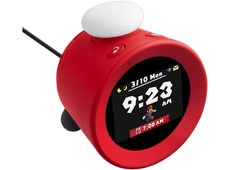User:The Other Jared/Sandbox
This is meant for pre drafts of whatever I want to do. May convert content to a full article later.
Nintendo Alarmo
Nintendo Sound Clock: Alarmo is a sound and alarm clock created by Nintendo. Alarmo launched on October 9, 2024 exclusively for Nintendo Switch Online members, then becoming a general retail product on March 10, 2025. Alarmo utilizes motion and light sensing radar technology to track the movement of a person while in bed.[1][2] During the night, these sensors can detect and track sleep patterns for the user to observe later. When an alarm is set for a certain time, Alarmo will start playing music and several sound effects in a manner similar to a traditional alarm clock, the music getting louder and more intense the longer the user stays in bed. When Alarmo detects the user has awoken and stood up, it will automatically stop by ending with a quick fanfare. Alarmo also has a dedicated button in case the user is in a living situation that makes it difficult for Alarmo to properly detect when someone has woken up.[3] Alarmo can also play soothing music to help the user fall asleep.
The music and sound effects used by Alarmo are sourced directly from various Nintendo games. Characters and iconography are also displayed on the LCD screen. Five games are supported at launch: Super Mario Odyssey, The Legend of Zelda: Breath of the Wild, Pikmin 4, Splatoon 3, and Ring Fit Adventure. Three additional games have been added via an update: Mario Kart 8 Deluxe, Super Mario Bros., and Animal Crossing: New Horizons, with more games promised to be added in the future.[4]
Relevance to the Super Smash Bros. series[edit]
A Super Smash Bros. Ultimate music and sound effect pack was added to Alarmo on (insert date here). The following music tracks were added:
and the following sound effects were added:
Gallery[edit]
References[edit]
See Also[edit]
Nintendo Music
Nintendo Music is a mobile app for IOS and Android devices that hosts a collection of music featured in Nintendo games.[1] The app is a free download for all active Nintendo Switch Online users. The app functions like other music streaming programs where music tracks are available to listen over the internet and download to listen while offline. All music tracks are sorted by game, as well as with both pre-made and user generated playlists based on themes like characters or moods. Each song can be extended or looped by increments of 15 minutes and an option to hide potential spoilers can be toggled per game.
Relevance to the Super Smash Bros. series[edit]
A Super Smash Bros. Ultimate music pack was added to the app on (insert date here). The following music tracks were added:
References[edit]
See Also[edit]

